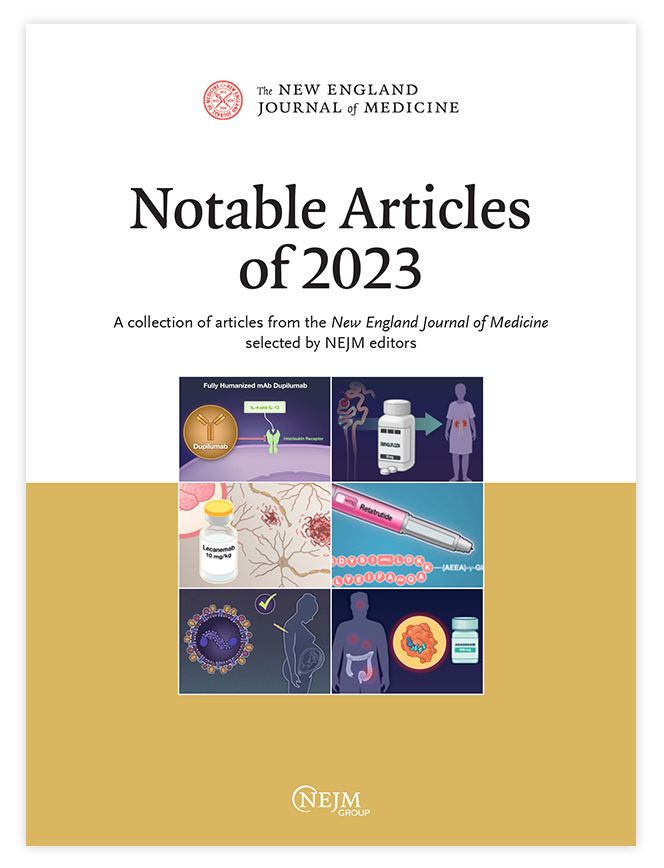Safety and Efficacy of Obicetrapib in Patients at High Cardiovascular Risk.
IF 96.2
1区 医学
Q1 MEDICINE, GENERAL & INTERNAL
引用次数: 0
Abstract
BACKGROUND Obicetrapib is a highly selective cholesteryl ester transfer protein inhibitor that reduces low-density lipoprotein (LDL) cholesterol levels. The efficacy and safety of obicetrapib have not been fully characterized among patients at high risk for cardiovascular events. METHODS We conducted a multinational, randomized, placebo-controlled trial involving patients with heterozygous familial hypercholesterolemia or a history of atherosclerotic cardiovascular disease who were receiving maximum tolerated doses of lipid-lowering therapy. Patients with an LDL cholesterol level of 100 mg per deciliter or higher or a non-high-density lipoprotein (HDL) cholesterol level of 130 mg per deciliter or higher, as well as those with an LDL cholesterol level of 55 to 100 mg per deciliter or a non-HDL cholesterol level of 85 to 130 mg per deciliter and at least one additional cardiovascular risk factor, were eligible for inclusion. The patients were randomly assigned in a 2:1 ratio to receive either 10 mg of obicetrapib once daily or matching placebo for 365 days. The primary end point was the percent change in the LDL cholesterol level from baseline to day 84. RESULTS A total of 2530 patients underwent randomization; 1686 patients were assigned to receive obicetrapib and 844 to receive placebo. The mean age of the patients was 65 years, 34% were women, and the mean baseline LDL cholesterol level was 98 mg per deciliter. The least-squares mean percent change from baseline to day 84 in the LDL cholesterol level was -29.9% (95% confidence interval [CI], -32.1 to -27.8) in the obicetrapib group, as compared with 2.7% (95% CI, -0.4 to 5.8) in the placebo group, for a between-group difference of -32.6 percentage points (95% CI, -35.8 to -29.5; P<0.001). The incidence of adverse events appeared to be similar in the two groups. CONCLUSIONS Among patients with atherosclerotic cardiovascular disease or heterozygous familial hypercholesterolemia who were receiving maximum tolerated doses of lipid-lowering therapy and were at high risk for cardiovascular events, obicetrapib reduced LDL cholesterol levels by 29.9%. (Funded by NewAmsterdam Pharma; BROADWAY ClinicalTrials.gov number, NCT05142722.).Obicetrapib在高危心血管患者中的安全性和有效性。
dobicetrapib是一种高选择性胆固醇酯转移蛋白抑制剂,可降低低密度脂蛋白(LDL)胆固醇水平。obicetrapib在心血管事件高风险患者中的有效性和安全性尚未得到充分的表征。方法:我们进行了一项多国、随机、安慰剂对照试验,纳入了杂合子家族性高胆固醇血症或有动脉粥样硬化性心血管疾病史的患者,这些患者接受了最大耐受剂量的降脂治疗。LDL胆固醇水平为100毫克/分升或更高,非高密度脂蛋白(HDL)胆固醇水平为130毫克/分升或更高,以及LDL胆固醇水平为55至100毫克/分升或非高密度脂蛋白胆固醇水平为85至130毫克/分升且至少有一个额外心血管危险因素的患者符合纳入条件。患者以2:1的比例随机分配,接受10mg obicetrapib每日一次或匹配安慰剂365天。主要终点是LDL胆固醇水平从基线到第84天的百分比变化。结果随机分组2530例患者;1686名患者接受obicetrapib治疗,844名接受安慰剂治疗。患者的平均年龄为65岁,34%为女性,平均基线LDL胆固醇水平为每分升98毫克。obicetrapib组LDL胆固醇水平从基线到第84天的最小二乘平均百分比变化为-29.9%(95%置信区间[CI], -32.1至-27.8),而安慰剂组为2.7% (95% CI, -0.4至5.8),组间差异为-32.6个百分点(95% CI, -35.8至-29.5;P < 0.001)。两组的不良事件发生率相似。结论:在动脉粥样硬化性心血管疾病或杂合性家族性高胆固醇血症患者中,接受最大耐受剂量的降脂治疗并处于心血管事件高风险的患者中,奥比西拉比降低了29.9%的LDL胆固醇水平。(由NewAmsterdam Pharma资助;BROADWAY ClinicalTrials.gov号码:NCT05142722)。
本文章由计算机程序翻译,如有差异,请以英文原文为准。
求助全文
约1分钟内获得全文
求助全文
来源期刊

New England Journal of Medicine
医学-医学:内科
CiteScore
145.40
自引率
0.60%
发文量
1839
审稿时长
1 months
期刊介绍:
The New England Journal of Medicine (NEJM) stands as the foremost medical journal and website worldwide. With an impressive history spanning over two centuries, NEJM boasts a consistent publication of superb, peer-reviewed research and engaging clinical content. Our primary objective revolves around delivering high-caliber information and findings at the juncture of biomedical science and clinical practice. We strive to present this knowledge in formats that are not only comprehensible but also hold practical value, effectively influencing healthcare practices and ultimately enhancing patient outcomes.
 求助内容:
求助内容: 应助结果提醒方式:
应助结果提醒方式:


